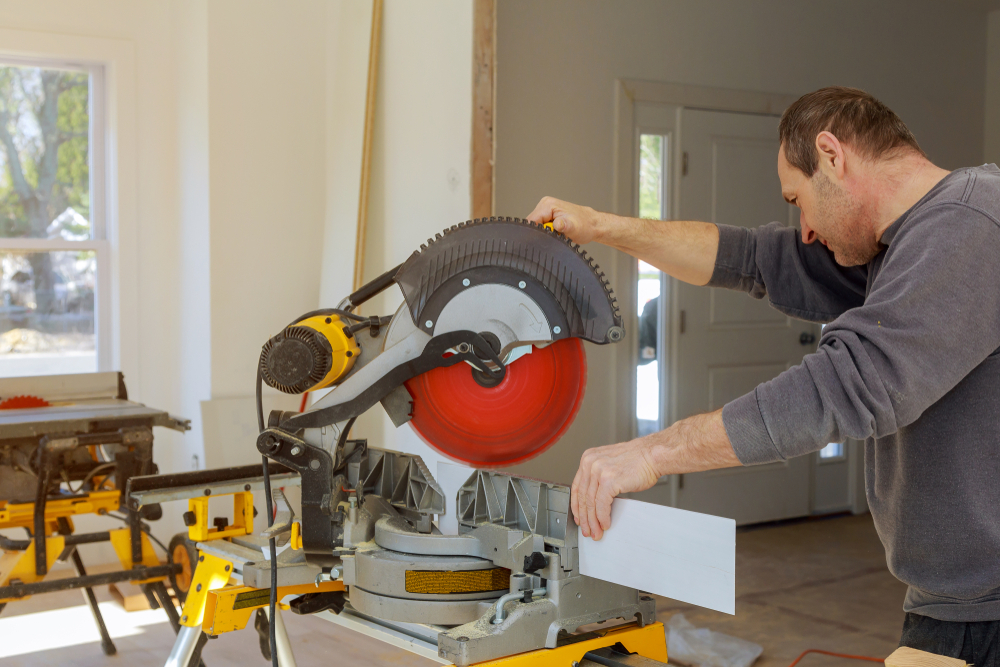A miter saw is a power tool used for making precise cuts at a variety of angles. It is commonly used in carpentry, woodworking, and other crafts.
It is important to use a miter saw correctly in order to ensure safety and accuracy. Incorrect usage can lead to injury or flawed cuts, which can ruin your project and waste materials.
Contents
Setting up the miter saw
Before using a miter saw, gather all necessary materials and tools. This may include the saw itself, a workbench or table, clamps, a push stick, a blade wrench, and any other specialized tools or equipment.
Adjust the blade and fence to the desired settings. The blade should be properly tightened and the fence should be aligned with the blade. Check the manufacturer’s instructions for specific details on how to adjust these settings.
Ensure that the blade is at the proper depth and orientation for the type of cut you will be making. A blade that is too deep or not properly oriented can result in inaccurate or uneven cuts.
Making straight cuts
- Set up the workpiece on the workbench or table, securing it in place with clamps if necessary. Make sure that the workpiece is properly aligned with the fence and blade.
- Position the miter saw blade so that it is aligned with the cut line on the workpiece.
- Operate the saw smoothly and accurately, following the manufacturer’s instructions for proper usage. Use a push stick to guide the workpiece through the blade if necessary.
Making angled cuts
Set up the workpiece on the workbench or table, securing it in place with clamps if necessary. Make sure that the workpiece is properly aligned with the blade.
Adjust the miter and bevel angles according to the desired cut. The miter angle determines the angle of the cut relative to the length of the workpiece, while the bevel angle determines the angle of the cut relative to the width of the workpiece. Check the manufacturer’s instructions for specific details on how to adjust these angles.
Operate the saw smoothly and accurately, following the manufacturer’s instructions for proper usage. Use a push stick to guide the workpiece through the blade if necessary.
Advanced techniques
Cutting compound angles: A compound angle is a cut that involves both a miter and bevel angle. To make a compound angle cut, set the miter and bevel angles as desired, then make the cut as you would for a straight or angled cut.
Cutting multiple pieces to identical lengths: To cut multiple pieces to the same length, set up a stop block or use a measuring tool to ensure that all cuts are made to the same length.
Using specialized blades: Different blades are designed for different materials and types of cuts. For example, a fine-tooth blade is better for making precise cuts in softwood, while a coarse-tooth blade is better for cutting through hardwood or plywood.
Maintenance and safety
Regularly clean and maintain your miter saw and blade to ensure optimal performance. This may include cleaning the blade and lubricating the moving parts, as well as replacing the blade when it becomes dull or damaged.
Wear proper protective gear when using a miter saw, including safety goggles, ear protection, and gloves.
Follow safe operating procedures when using the saw, such as keeping your hands and fingers away from the blade and using a push stick to guide the workpiece through the blade.
Types Of Miter Saws
There are several types of miter saws available, each with its own unique features and capabilities. Here are some common types of miter saws:
Standard miter saw
This is the most basic type of miter saw, and it is designed for making straight and angled cuts in various materials. It typically has a blade size of around 8 to 12 inches and is powered by an electric motor.
Compound miter saw
This type of miter saw is similar to a standard miter saw, but it also has the ability to tilt the blade to make bevel cuts. This allows you to make compound angle cuts, which are angled cuts that involve both a miter and bevel angle.
Sliding compound miter saw
This type of miter saw has a blade that can both tilt and slide along a rail, allowing it to make longer cuts than a standard or compound miter saw. It is typically larger and more expensive than other types of miter saws, but it is also more versatile and can handle a wider range of materials.
Dual compound miter saw
This type of miter saw is similar to a compound miter saw, but it has two blades that are mounted on opposite sides of the saw. This allows you to make compound angle cuts on both sides of the workpiece at the same time, which can be useful for certain types of projects.
Chop saw
A chop saw, also known as a “cut-off saw,” is a type of miter saw that is designed for making straight cuts through materials such as metal and plastic. It typically has a much larger blade size than other types of miter saws and is powered by a high-speed electric motor.
Making an Extension Fence
An extension fence is an accessory that can be added to a miter saw to allow it to make longer cuts. Here are the steps for making an extension fence for a miter saw:
Gather materials
You will need a piece of wood or other material for the extension fence, as well as screws or other fasteners to attach it to the miter saw. You may also need a drill and drill bits if you are using screws to attach the extension fence.
Measure and cut the extension fence
Measure the length of the existing fence on your miter saw and cut the extension fence to the same length, or slightly longer if desired. Make sure that the extension fence is wide enough to provide adequate support for the workpiece.
Attach the extension fence to the miter saw
Place the extension fence against the existing fence on your miter saw, aligning it with the blade. Use screws or other fasteners to attach the extension fence to the miter saw, making sure it is secure and level.
Test the extension fence
Once the extension fence is attached, test it out by making a few cuts with your miter saw. Make sure that the extension fence is providing adequate support for the workpiece and that the cuts are straight and accurate.
Adjust as needed
If the extension fence is not providing adequate support or the cuts are not straight, make any necessary adjustments to the extension fence or the miter saw itself.
Using an extension fence can be a useful way to make longer cuts with a miter saw, but it is important to make sure that the extension fence is secure and properly aligned with the blade in order to ensure accuracy and safety.
Conclusion
Using a miter saw is a valuable skill for anyone who works with wood or other materials. By following proper safety guidelines and setting up the saw correctly, you can make precise and accurate cuts at a variety of angles.
Practice and proficiency with a miter saw will come with time and experience, but by following the steps outlined above and consulting the manufacturer’s instructions, you can become confident and proficient in using this powerful tool.

